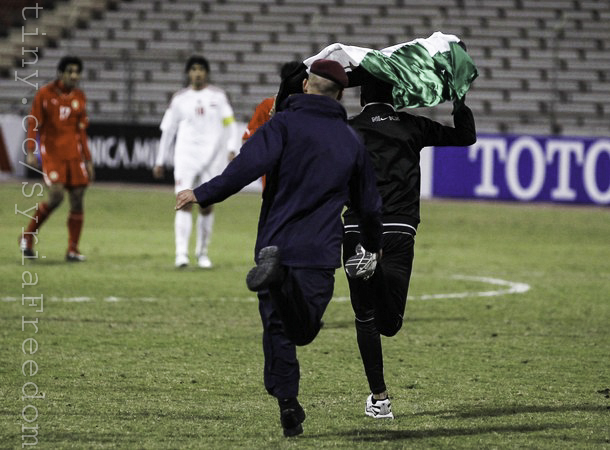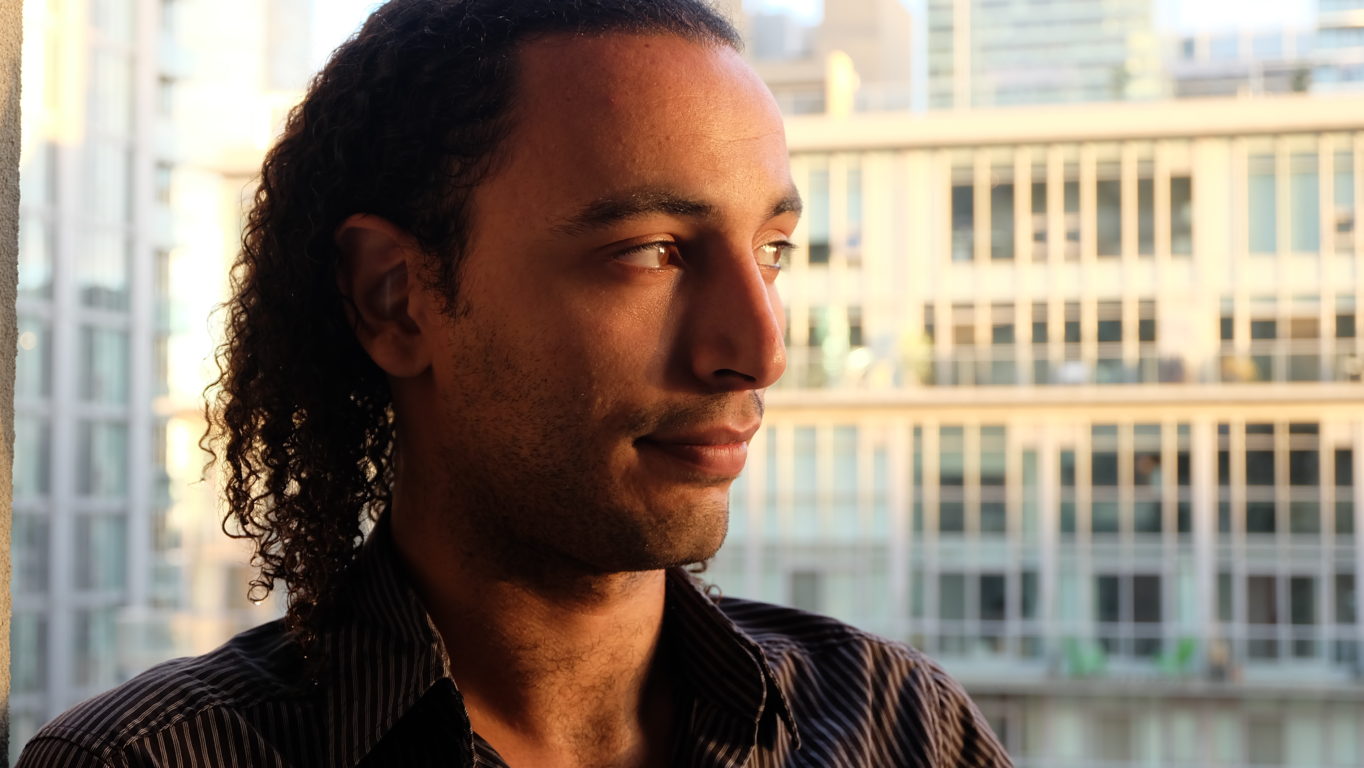[This article is the outcome of a partnership between SyriaUntold and openDemocracy's Arab Awakening].
For the first time in over five years, locals from Western Aleppo gathered to watch a football derby in the war-torn city on January 28, 2017. Citizens of all age groups flocked to the event with renewed vigor and excitement.
Some praised the return of football to Aleppo, and, in turn, the return of safety and security to the once-vibrant city. They cheered and chanted songs on drums and trumpets, and celebrated heartily when local side Al-Ittihad, one of the most successful clubs in Syrian football history, defeated longtime rival and fellow Aleppo-based team Al-Hurriya 2-1.
Over the past few years, both teams were unable to play on home turf because of the ongoing conflict. Yet for one afternoon, Aleppo was given a bittersweet reminder of its favorite pastime -- a fleeting glimpse of normality that simply no longer existed.
While many used the opportunity to distract themselves from the hardships endured over the past few years, it was difficult to ignore the tarnished stadium, damaged by bombing campaigns, or the heavily armed riot police conspicuously patrolling the stands. Even the pitch, usually a pleasant shade of green, had turned chestnut brown and withered. Nothing in Aleppo had withstood the effects of war.
The event, which was broadcast on state television, was an attempt to emphasize the dramatic shift in local sentiment following the major offensive that allowed the Syrian government to regain complete control of Aleppo from rebel forces for the first time since the city was initially divided in 2012. State media interviewed players, coaches, and fans from both teams, all of whom praised the “return of happiness to the souls of the people of Aleppo.” All the while, an enlarged banner of Syrian President Bashar Al-Asad hung over the crowd, watching with motionless eyes.
And yet, while western outlets such as the BBC and The Sun celebrated the return of sports to the war-torn city, several local journalists questioned the government’s intent with the latest display of stagecraft. For many, this was a show of might by the Syrian government, one that came at the expense of tens of thousands of dead or displaced Syrians.
“This is a media war, to show the regime has gotten Aleppo back and made it safe,” said Thaer, a Syrian citizen journalist living in Turkey who spoke to CNN. “They forced half of Aleppo’s residents out of their homes. They made them refugees all over the world. These are lies. It is very upsetting to see, after all the bloodletting and all the martyrs who died, the regime is acting as if nothing happened. They are playing football on the ruins of Aleppo.”
While January 28 was a moment when a select few citizens rekindled some semblance of happiness in the wake of mass devastation, it was also an attempt by the Syrian government to use football as a tool to enhance its own image as liberator.
Furthermore, the match was turned into a superficial distraction for the remainder of the world pleased to see sports in areas ravaged by war and severe conflict -- a longstanding component of football diplomacy in the hands of authoritarian regimes. It became evidently clear that this was the latest example of Bashar al-Asad using sports as a tool to exert political influence.
Political Theatre on a Football Field
Over the past six years, Syria has gradually descended into a civil war -- a bloody struggle for freedom that began during the ill-fated Arab Spring in 2011. The multi-sided conflict, which involves Asad’s governmental forces and various opposition groups vying for power, yielded widespread devastation and societal fragmentation. The conflict seeped into the very fabric of Syrian society, and encompassed all facets of daily life.
Throughout the conflict, which has cost the lives of hundreds of thousands of Syrian citizens and displaced millions more, Bashar al-Asad has maintained control of the official government. His regime exerts influence over controlled regions, which naturally includes complete control over Syrian sports and the beloved football league.
Given the geographic limitations of Asad’s territory within Syria, the league is primarily focused in two cities, Latakia and Damascus. And yet, despite Asad’s constant attempts to present a unified and thriving professional sports environment over the past few years, Syrian football is a shadow of its former self.
“The government views football like a Syrian drama. The quality doesn’t matter,” Muhammad Fares, a Syrian journalist covering the political side of football, told me. “It is a job market for Syrian players, who have families. If you stop the league, they will lose their source of income. The state also used football to offer the façade of a functioning government, and many players were killed under these circumstances. Yet you still have to go play and pretend nothing is going on. It is a dictatorial regime, and such regimes don’t care whether you live or you die as long as you maintain the state’s image.”

This led to severe fragmentation within the league ranks stemming from the division between pro-Asad supporters and repressed dissenters. Eventually, those like Mohammed Jaddou, a former captain of Syria’s under-16 squad, fled with their families on harrowing voyages across the Mediterranean to seek refuge.
“[The Syrian government] used to threaten to end my career and punish me if I did not show up for a training camp,” Jaddou told Bleacher Report in 2015. “The government also threatened to call me a deserter and sue me if I ever left the team." Syrian footballers, even teenage ones, were primary targets because of their publicity as national athletes.
Apart from the constant fear of the ever-watching Syrian government, there were threats from opposition forces. Jaddou believed that, had he fallen into rebel hands during his time on the team, he would have “probably die[d],” citing a scenario where his team was caught in the crossfire of a shoot-out between opposing factions where “missiles and bombs fell around our bus.” As long as he was representing the national team, he was viewed as an enemy. Other players were actually blown up by armed rebels.
Apart from the geopolitical chaos that plagued the Syrian Premier League, the sport suffered under the weight of economic woes and imposed sanctions that left its coffers empty. FIFA followed suit and blocked $2.25 million in funding earmarked for the Syrian Football Association (SFA) in fear that the funds would instead be redirected at Baath Party political activity or military financing.
However, despite the skeletal state of the league by 2017, Asad continues to present the façade of a successful league radiating with pride and Syrian nationalism. The return of football to Aleppo, a city that the regime regained control over in December 2016, is simply the latest example of football theatrics for propaganda purposes.
A History of Politicized Football
Syrian football only took form as a viable profession with competitive income following Bashar al-Asad’s ascension to the presidency in July, 2000. While Bashar’s father, Hafez al-Asad, had made a point to offer financial security and improved social standings to champion athletes who medaled at the Arab, Asian, Mediterranean and Olympic Games, it wasn’t enough to motivate aspiring athletes to focus on a career in sports. When Bashar succeeded his father, he invested heavily in the League, which he viewed as an opportunity to enhance Syria’s image abroad.
“Prior to the beginning of Bashar al-Asad’s presidency, it would have been difficult to call Syrian footballers ‘professionals.’ The players were not given a good salary and had no media recognition,” Fares explained. “But by 2003-04, players were becoming stars and were paid well. Pitches improved and football clubs began to bring in foreign players and foreign coaches. More money was being invested in the game.”
With each added investment, Asad exercised more control over football. His influence over the sport led to increased nepotism, corruption, and contributed to aggravating existing ethnic tensions between teams of different backgrounds. A notable example of this was the clashes that took place in 2004 between Kurdish and Arab football fans during a match in Qamishli. Security forces within the stadium responded by firing at the Kurdish crowd, reportedly killing seven. The fact that the regime ‘sided’ with Arab supporters was widely perceived as the umpteenth form of discrimination against Syria’s Kurds, following a long string of culturally and politically repressive policies.
Matters escalated the following day, as Kurdish protestors burned down the local Baath Party office and later toppled a statue of Hafez al-Asad. The chaotic events eventually led to the deployment of troops to put an end to the Kurdish uprising. At least 36 people, mostly Kurds, were killed in total and over 160 were injured as Asad forcefully restored order to the city. From that day onwards, there was little doubt that football had become a medium for political influence.
“Football is a politicized sport, though is particularly politicized within Syria,” said Fares. “The image of the president was always hanging over the crowds at stadiums and winning players and teams had to pay their respects to their president in public.”
However, Asad’s use of football-related propaganda dramatically shifted in purpose following the 2011 uprising across Syria. Fearing mass unity and opportunities for large gatherings, he suspended the 2010-11 season while government authorities rounded up any athletes who appeared to be part of the newly formed opposition. Many players were tortured and executed in regime prisons.
“I believe the Syrian regime is terrified of football,” Fares added. “It is the reason why the government suspended the league during the early days of the uprising in 2011. The government didn’t fear riots from those gatherings, they feared organization.”
Yet despite the conflict reaching its sixth year, Asad continues to use football for political gain. In 2012, he hosted the Syrian national football team at his palace on Mt. Mezzeh and congratulated them on representing Syria proudly and winning the West Asian Football Federation Championship. Asad rewarded each player with an apartment, a government job, and 150,000 Syrian Pounds (approximately $ 1400 at the time).
Celebrating with a team that included Mosab Balhus, the Homs-based goalkeeper who was arrested on suspicion of “sheltering rebel fighters,” showed Asad as a gracious leader willing to forgive past transgressions -- more personal enhancement through sports.
Given Asad’s consistent use of football as a weapon to exert his influence, it comes as little surprise that Aleppo became his latest setting for political theatrics. International media gleefully reported on the return of football to Aleppo following its destruction, and on how the local derby represented a dramatic shift in the region.
This romanticized reporting is simply not the case, and instead helped Asad present the image of a leader restoring happiness in a historic city after liberating it from his enemies. While no other football games have been played in Aleppo since January, the derby remains a testament to how powerful the effect of a single strategically positioned match can be on a dictator’s image.
[Main photo: Football match between Jordan national football team and Syria national football team in Shahid Dastgerdi Stadium, Tehran (neutral field). 2015 AFC Asian Cup qualification - 15-8-2013 (Javid Nikpour/CC BY 4.0, via Wikimedia Commons)].




